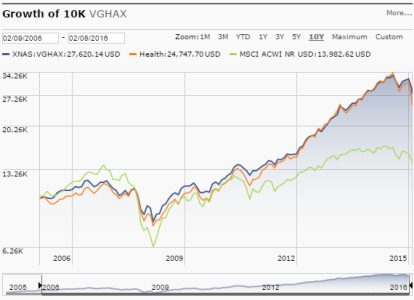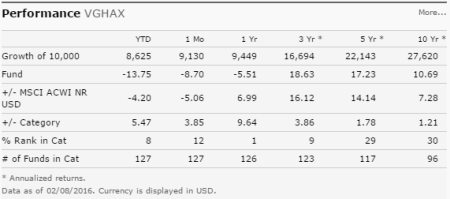
Morningstar is research firm that provides data and analysis on a wide range of investments including individual stocks, mutual funds and exchange traded funds. Morningstar serves retail clients as well as investment professionals.
In this three part series, I want to provide investors with an educational review and critique of data available from Morningstar. My goal is to help client and non-clients become familiar with the excellent information available through Morningstar’s web site and add-on services. Whether you manage your own money, or have a financial advisor, the services available from Morningstar can help understand your mutual funds and ETFs.
For this article, I am going to use the Vanguard Health Care Admiral Fund (ticker VGHAX) as an illustrative example. Being mindful of Morningstar copyrights, I will provide some embedded examples in the article and will also provide links for the user to go directly to Morningstar’s site. The article will be broken into three parts. In part 1, I will focus on fund composition and Morningstar ratings. In part 2, we will go deeper into understanding the funds risk and return characteristics and explore the fund’s performance relative to an appropriate benchmark. In part 3, I will cover miscellaneous topics such as evaluating the fund manager and tax considerations.
Before beginning I wanted to make a note about the investment process. Generally, investment portfolio management includes the following steps: financial plan, appropriate asset allocation, implementation and ongoing performance & monitoring. This article is focused on topics related to fund implementation and performance monitoring. To provide some context, I selected the Vanguard Health Care fund given because we currently hold this fund in Brightwood model portfolios. Furthermore, I selected this fund because it is an actively managed fund. Please do not consider this article to be an investment recommendation. A personal financial plan is a prerequisite for any recommendations made by this advisor.
Shall we dive in?
Overview
Starting at www.morningstar.com, you will see an input dialogue at the top of the page with a Quote dialogue box. Enter the symbol ‘VGHAX’ in the box to begin. This takes us to the following quote page.
Morningstar Ratings
Morningstar ratings appear at the top of the page. Morningstar provides two different ratings. The first the Morningstar ‘star’ rating system. This system is ‘backward looking’ and grades the fund based on past risk and return relative to funds in the fund category. The second rating is a forward looking estimate based on Morningstar’s analysis. Morningstar reviews the fund based on process, performance, people, parent and price (value/expenses).
Does Morningstar’s star rating predict performance? The answer to this question has been heavily researched and debated. Based on a research paper from Vanguard, you have less than 50% chance of having a fund selected by star rating outperform it’s benchmark over the subsequent three year period. Based on their data, 1 star funds actually did slightly better than 5 star funds. They cite additional research and note: ‘One common theme in most of the studies is the difficulty active managers face in simply outperforming a benchmark over time, regardless of their prior performance. ‘. Morningstar also reviewed star ratings here. Their review argued that the star rating does provide value and placed heavy emphasis on the idea that 1-star funds are more likely to be closed. The conclusion of the article was:
“Investors should make expense ratios a primary test in fund selection. They are still the most dependable predictor of performance. Start by focusing on funds in the cheapest or two cheapest quintiles, and you’ll be on the path to success. (Remember, we highlight funds with expense ratios in the cheapest quintile in the data pages in the back of FundInvestor.)
Stars can be helpful, too, particularly in identifying funds that might be merged out of existence. Even if a 1-star fund starts to perform better, there’s always the danger that the fund company will decide that its track record is too poor and will fold the fund, forcing you to move your money elsewhere.”
How do I use star ratings in fund selection? I give expense ratios and regression analysis greater weight than star ratings. Over time, low cost funds outperform high cost funds. The lowest cost funds tend to be index funds and fundamentally weighted funds. Index funds are called ‘passive’ funds because there is no attempt to pick winners. We do use actively managed funds, such as VGHAX, but we put more weight on regression analysis than star ratings. In my experience, I have found better regression results for low-cost, active funds compared to high-cost active funds.
Additional Summary Information
Additional information found at the top of the quote page includes:
TTM Yield: 1.27%
Load: none
Expenses: .29%
Fee Level: Low
30day SEC Yield: .99%
Category: Health
Style: Large Growth
TTM yield is the income distributions in the last 12 months divided by current price. The SEC yield takes income distributions over last 30 days, deducts expenses and divides by current price. Given VGHAX holds stocks, the income this fund generated is primarily generated by dividends from the underlying stocks.
Growth of 10K

The quote page includes the graph found at the right.
This chart gives a graphical view for how $10,000 invested in the fund performed over the last 10 years. It is important to note that this chart includes the assumption that dividends are reinvested in the fund. Note that the graphic includes two additional equity lines. First, the ‘Health’ equity line is Morningstar’s internally defined index for the category to which the fund has been assigned. Secondly, the ‘MSCI ACWI NR’ is an index that created by MSCI comprised of stocks across a wide range of countries (ACWI – All Country World Index). This index is included because it was identified by the mutual fund as the ‘primary prospectus benchmark’. I want to make special note of both of these indices. When we evaluate additional fund statistics including risk and return we need to be very careful in understanding the reference benchmark that is being used. In cases, the ‘primary prospectus benchmark’ can be misleading. In the case of Vanguard Health Care Fund, the Morningstar index based on the Health sector may be a more appropriate benchmark than an all country index (MSCI ACWI NR).
I like to visually inspect this chart to get a sense for how volatile the returns have been. I also like to look at the maximum drawdown (largest % drop from peak to valley). Note that in the downturn of 2008-2009 this fund experienced a lower drop or ‘max drawdown’ than either of the two indices.
Performance

Also included on the quote page is the following performance table:
The table gives a concise summary of total return for the fund and compares this with the primary benchmark and the Morningstar category benchmark. Finally, the % rank in Category give us a ranking from 1 – 100 (1 being the best) for how this fund performed relative to the other funds in its category. The category rank is focused on performance only. It is important to also understand risk relative to the category as well.
Ratings and Risk
A table on the right of the page indicates that the ‘risk’ for the fund is ‘low’ and that the return for the fund is ‘average’. These ratings come from looking at the risk and return of the 125 funds Morningstar has in the health category broken into five groups.
Asset Allocation
The asset allocation graphic identifies that the fund is currently weighted with ~75% US and 20% non-US. Vanguard Health Care has historically carried a heavy weight on US equities. For this reason I find the MSCI ACWI to be a marginal choice for benchmark purposes.
Fillings
Finally I wanted to note that the quote page includes access to the fund’s prospectus and additional reports such as the Annual Report. Before investing, review the most recent prospectus and Annual Report. In addition, I like to go to the fund sponsor’s web site where you can get additional information on the fund not found on Morningstar. For VGHAX, check here.
Conclusion
As we can see from the discussion, the Morningstar quote page for a fund is a compact summary of the fund. We have discussed the fund category, benchmarks, risk and return, category rankings as well as the allocation by geography. In the part 2, we will take a deeper dive into evaluating the fund’s performance and risk.